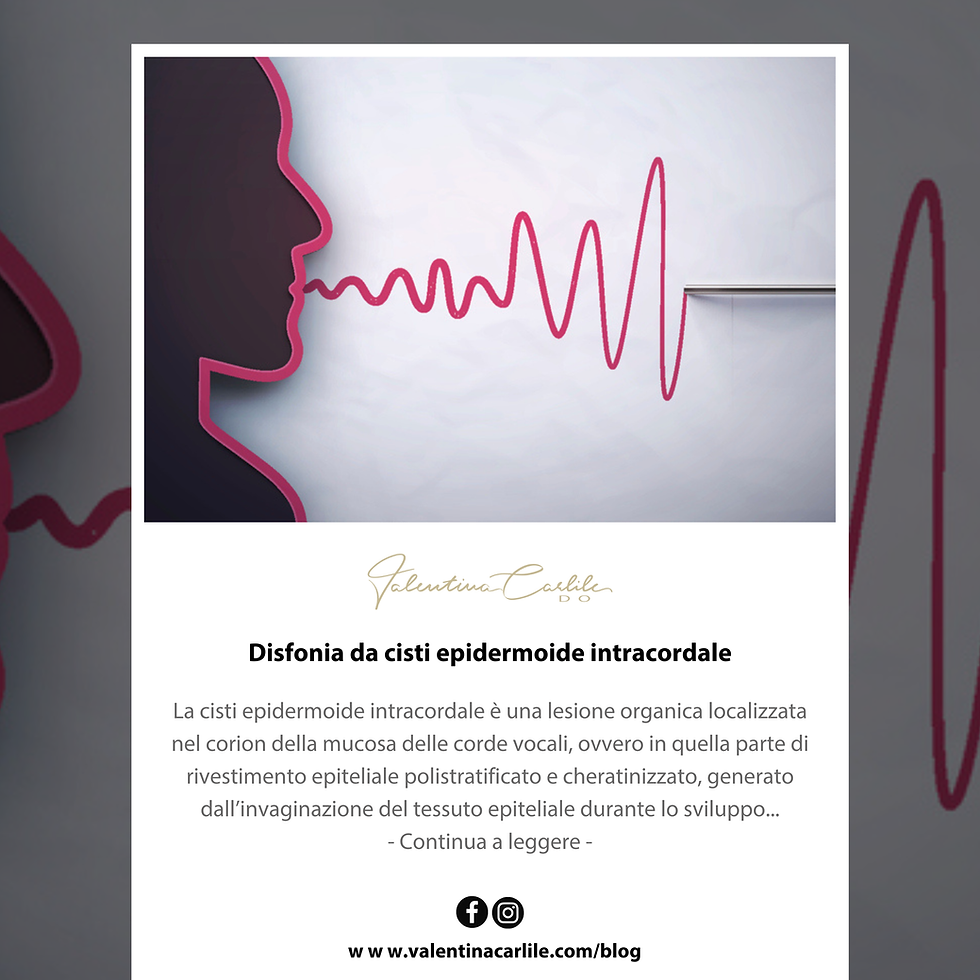Causes of dysphonia
- Valentina Carlile DO

- Jan 27, 2015
- 2 min read

Any physical condition that impairs the normal function of the abdominal muscles can be suspected as a cause of dysphonia. This, for example, occurs in pregnancy, or in the presence of a sprained ankle or a broken leg that require the use of an unusual posture to balance, modifying abdominal support and, potentially, causing voice dysfunction. Any neurological disorder that causes tremors, endocrine disorders such as thyroid dysfunction or menopause, the aging process, and other systemic conditions can alter the voice. It must always be remembered that anomalies of almost all body systems can cause vocal dysfunctions and therefore we must not stop at the evaluation of the head and neck.
As for the oral cavity, lymphoid hypertrophy associated with a scratchy voice and irritative cough can indicate a chronic infection. Bruxism is an indication of excessive tension and can be associated, for example, with a dysfunction of the TMJ (temporomandibular joint), a joint that should always be evaluated.
The examination of the neck should reveal the presence or absence of abnormal masses, excessive muscle tension (anterior or posterior), scars from previous surgical outcomes. Particular attention should be paid to the thyroid gland, every palpation and / or correction maneuver should always be respectful of this tissue. The evaluation of the vertical mobility of the larynx is fundamental as its inclination, due for example to the partial fixation of the muscles cut during a previous operation, can produce vocal dysfunction. An examination of the cranial nerves should always be included, particularly if there is a history of "cold sores". Finding a decrease in sensitivity of the 5th cranial nerve, deviation of the palate, or other cranial nerve deficits, even mild, may indicate mild cranial polyneuropathy, or more simply, entrapment or compression. Neuropathies from postviral infections can involve the superior laryngeal nerve and cause weakness, fatigue, and loss of vocal range. Debilitating conditions such as mononucleosis or chronic anemia can result in vocal fatigue.
Finally, it is essential to have in mind the cases of dysarthria and dysphonia characteristic of serious neurological diseases. A dysarthria is a defect in rhythm, speech, and articulation and usually results from neuromuscular failure or weakness. However, it can depend on oral dysfunctions. A dysphonia, on the other hand, is a vocalization abnormality usually resulting from problems in the larynx. Flaccid dysarthria is found in diseases of the lower motor neuron or primary muscle, such as myasthenia gravis and tumors involving the nuclei of the brain stem; spastic dysarthria in upper motor neuron pathologies (pseudobulbar palsy) in emerging multiple sclerosis and cerebral palsy; ataxic dysarthria is found with cerebellar disease, alcohol intoxication, and degenerative diseases, including multiple sclerosis; hypokinetic dysarthria is typical of Parkinson's disease; hyperkinetic dysarthria can be spasmodic, as occurs with chorea, cerebral palsy, and other diseases; mixed dysarthria is found in ALS.





Comments